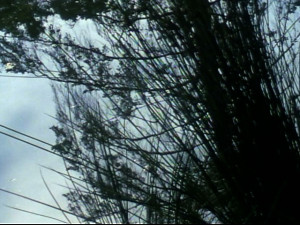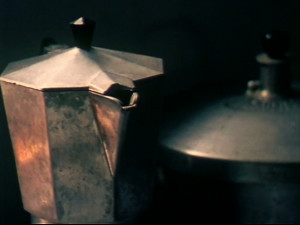Now available: six exhibition files from Sandra Davis
Posted June 10th, 2019 in New Acquisitions, News / Events
For all its tactility and materiality, filmmaker Sandra Davis’ use of 16mm film is rarely left a question of form. Throughout a body of work produced from the late 1970s through the present – an oeuvre at once intimate and elusive – Davis has repeatedly returned to physicality and touch as key themes activated by her choice of medium. (Jesse Cumming, “An Architecture of Desire: The Films of Sandra Davis“)
Six exhibition files from Sandra Davis are now available to rent from Canyon Cinema.

Crepescule: Pond and Chair (2001 | 6.5 minutes | COLOR | SOUND)
My brother was disabled by muscular dystrophy and used a wheelchair for most of his life. Despite the long, gradual degeneration of his physical condition, he lived with great spirit and heart, married, raised two children, volunteered for his church and was still working at his profession and building his fish pond on his land, when he died suddenly of complications of MD at age 52. He was my only brother and when I myself was disabled 13 years ago in an auto accident, his attitude of practical adaptations to physical impairments was one that made it easier for me. In an irony of life, a little Christmas message from him arrived two days after his sudden death. This event impelled me to respond with a film. The chair was his mobility in life; the pond he created was his dream.

A Preponderance of Evidence (1999 | 46 minutes | COLOR | SOUND)
Three women telling their own stories in a non-narrative, non-documentary form. How do inner conflicts of intimacy, sexual need, and violent impulses emerge in personal relationships? The evidence includes testimonies describing experiences of sexuality, love relationships, births, illegal abortions, adolescence as a Jew in revolutionary Russia and in the Protestant US Midwest. Private anecdotes illuminate societal realities of race, culture and gender. My “story” contributed contradictory images: the archaic Florida swamp, the elegant forms of European medieval architecture, Congress and Anita Hill, the mermaids of Weekie Wachee, victim heroines of European opera, abstract color and light explorations. Bits of 1950s educational films testify to scientific belief in cause and effect and stupefying patriarchal convictions of “how to” grow up well, avoid “going bad” and get a date for the prom.

A La Campagne, A Khan-Tan-Su (Into the Country, to Khan-Tan-Su) (1992 | 2.5 minutes | COLOR | SOUND)
The colors and breezes of the countryside and house in Normandy. The blue crockery, the yellow lichen, and where the key in the monastery kitchen leads.

Une Fois Habitees (Once Inhabited) (1992 | 6 minutes | COLOR | SOUND)
Some particular spaces, inhabited awhile ago. Looking back into the Parisian courtyard, looking at the ladies at the villa, looking into the secrets of the chapel of the delinquents. Light sculpts space; shadow describes form.

Au Sud (To the South) (1991 | 6.5 minutes | COLOR | OPT)
The specific colors and tones and rhythms of a place in the south of France. The dryness of gold, the rock of plateau, the cemetery of the sailors, the echoes of fishermen and artists, the memory of Paul Valery. And water everywhere.

Maternal Filigree (1980 | 18 minutes | COLOR/B&W | SILENT)
“MATERNAL FILIGREE is obviously vision rising thru inwards… it trembles like poetry, music – its rhythms OF and-at-one-with the experience itself. You have stitched a meaningful weave of symbolism throughout but always in the sense ‘make it new’ (as Pound translates the Chinese), so that symbol rubs and clashes with symbol, so that each is always vibrant, so that no symbol could harden midst the frets and stops of your ‘music’ – that symbols be felt beyond any set to of understanding… that none of them be ever anything like pomposity/(the known) but rather always sensual.” (Stan Brakhage)


